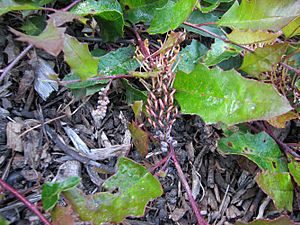Creeping grevillea facts for kids
Quick facts for kids Creeping grevillea |
|
|---|---|
 |
|
| Scientific classification | |
| Genus: |
Grevillea
|
| Species: |
repens
|
Grevillea repens, also known as the creeping grevillea, is a low-growing, woody plant. It is a type of shrub that only grows naturally in Victoria, Australia. This plant is part of a group called 'southern holly-leaf grevilleas'. It is very similar to another plant called Grevillea obtecta.
Contents
What Does Creeping Grevillea Look Like?
Size and Flowers
The creeping grevillea can spread out quite wide, up to 3 metres across. It produces special flower clusters that look a bit like a toothbrush. These flowers mostly appear from mid-spring to mid-summer. In Australia, this means from October to January.
The flowers have parts called perianths, which are usually light green or grey. They also have long, thin parts called styles. These styles are often dark red. However, they can also be deep maroon, dull pink, salmon, or even green.
How Flowers Work
The tip of each style has a green part called a pollen-presenter. This is where pollen, which is like a fine powder, collects from other parts of the flower called anthers. This happens when the flower is still a bud.
Grevillea repens needs pollen from other plants to make seeds. This process is called outcrossing. Birds, especially honeyeaters, are very important for this. They visit the flowers to drink the sweet nectar. Insects, like honey bees, also visit the flowers often.
Where Does Creeping Grevillea Grow?
Natural Homes
You can find Grevillea repens in mountain eucalypt forests. It grows in two main areas in central Victoria. One area is in the east, around Kinglake. The other is in the west, near Daylesford. There is also a smaller group of these plants southeast of Daylesford, in the Lerderderg Gorge area.
How They Grow and Reproduce
Plants from the Kinglake area can make new plants in two ways. They can grow from seeds, or they can grow new plants from their roots. This root growth is called 'root-suckering'. These plants often produce fewer seeds.
Plants from the Daylesford and Lerderderg Gorge areas mostly grow from seeds. They can also regrow from a special woody base called a lignotuber. This happens after events like a bushfire.
Some plants in the Kinglake area have three sets of chromosomes. This is unusual, as most plants of this species have two sets.
Flower Colors in Different Areas
The plants from the western areas (like Daylesford) have the most different flower colors. Their styles can be green to dark red. Plants in the eastern areas (like Kinglake) have styles that are dark red to deep burgundy. Almost all the plants in the Lerderderg Gorge area have green styles.
History and Protection
The Grevillea repens was first officially described by a botanist named Ferdinand von Mueller. He wrote about it in 1854.
This plant is considered "Rare in Victoria." It is listed on the Advisory List of Rare Or Threatened Plants In Victoria. This list is put together by the Department of Sustainability and Environment.

